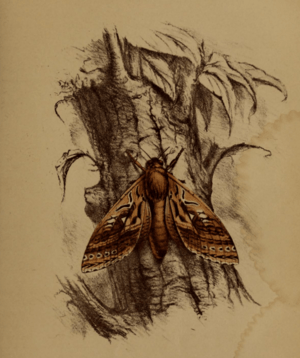Buller's moth facts for kids
Quick facts for kids Buller's moth |
|
|---|---|
 |
|
| Scientific classification | |
| Kingdom: | |
| Phylum: | |
| Class: | |
| Order: | |
| Family: |
Hepialidae
|
| Genus: | |
| Species: |
A. mairi
|
| Binomial name | |
| Aoraia mairi Buller, 1872
|
|
| Synonyms | |
|
|
Buller's moth (Aoraia mairi) is a type of moth that might be extinct. It is special because it is endemic to New Zealand, meaning it is found only there. We know about this moth from just one example, called a specimen.
This single specimen was found in the Ruahine Range mountains. Sir Walter Buller discovered it during a trip in the summer of 1867. He was actually looking for a bird called the huia at the time. Buller named the moth Porina mairi to honor his brother-in-law, Captain Gilbert Mair. Buller said the moth had a very large wingspan, almost 6 inches (150 mm) wide! This big size helps scientists know it's not other similar moths.
The only known specimen of Buller's moth was sent to the British Museum in 1890. It traveled on a ship called the Assaye. Even though that ship was reported to sink later, it happened on its way back from Britain. This means the moth specimen probably made it to Britain safely. However, no one knows where this important moth specimen is today. Its current location is a mystery.
What Happened to Buller's Moth?
In 1975, scientists found two caterpillars in the Orongorongo River valley. These caterpillars seemed new to science. Researchers tried to raise them to become adult moths. They wanted to see if they were Buller's moth caterpillars or a new type of giant moth. Unfortunately, they could not confirm what kind of moths they were. Later studies suggested these caterpillars were likely from other known moth species. These included D. characterifer or Aoraia enysii.
Why Is This Moth Important?
Buller's moth is considered "unevaluated" on the Department of Conservation Threat Classification lists. This means experts are not sure about its conservation status. The original specimen of the moth is either lost or destroyed. Also, no one has seen this specific moth since it was first described. This makes it hard to know if it still exists in New Zealand.

